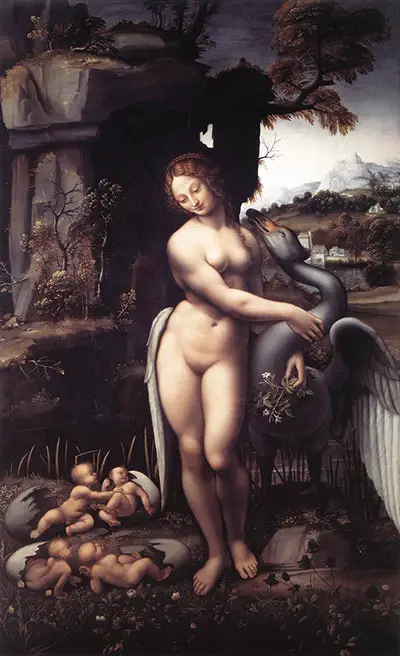When Zeus, king of the gods, saw Leda, he was so smitten by her beauty that he changed into a swan and coupled with her. Leda gave birth to two eggs, and each egg hatched twin babies.
The twins were Pollux and Clytemnestra, and Castor and Helen, characters that grew up to feature in other Greek legends. Paris abducted the adult Helen, and made her the legendary princess of Troy.
In the image, Leda looks down tenderly upon her babies, while the curves of her body stand in counterpoint to the sinuous lines of the swan, its head resting upon her shoulder.
The image is also allegorical; the sprig of white blossom that Leda holds in her hand is a symbol of purity. Her slightly uncomfortable stance, with the babies on one side and the swan on the other, suggests that she is riven between the human world and the magical event that has just happened to her.
In contrast to the mythical nature of the story, the setting is naturalistic. Over Leda’s left shoulder, we see a granite block with carvings upon it. Over her right shoulder is a small, medieval town. The sky overhead and the ground underneath are similarly realistic. Leonardo’s development as an artist explains this realism.
Leonardo was born in the town of Vinci, Tuscany, in 1452, the son of a lawyer. In his youth, Leonardo would go into the countryside near his home and collect plants and small animals. He would then practise drawing each species carefully into one of his notebooks, rendering every detail accurately and intricately.
Over time, these renderings of the natural world became the hallmark of Leonardo’s genius. This accuracy can be seen in the image, the rendering of the swan’s wing and feathers, the clouds in the sky, and the grass and foliage. The town in the background is almost certainly the depiction of a real Tuscan village. In addition to accurate drawing, Leonardo heralded the subtlest renderings of light and colour ever used in western art.
He began the craft of painting at a time when artists were discovering the possibilities of the oil medium, and gentle and realistic shadings in contrast to the brighter colours of tempera-based paint. Medieval artists had excelled in depicting the spiritual world, heaven, angels and saints, with tempera paints and gold leaf.
But the mercantile, post-medieval world demanded realism in painting. The subtlety of the oil medium enabled Renaissance artists to achieve this realism. Leonardo brought oil painting to a virtuoso level with his technique of applying layer upon layer of oil-based tinted glazes onto his surface until he achieved the effect he wanted.
This technique brought about a soft, misty effect to the edges of objects in his paintings, which was called “sfumato” or smoke. It can be seen in Leonardo’s most famous painting, the Mona Lisa, painted between 1503-1507. Later artists copied Leda and the Swan from Leonardo's drawings and also this painting technique.


